No.260 - "ニーベルングの指環" 入門(4)英雄・神秘 [EX.115-161] [音楽]
|

| ||
|
リヒャルト・ワーグナー
「ジークフリート」
ゲオルグ・ショルティ指揮
ウィーン・フィルハーモニー管弦楽団 (新リマスター版CD 1997。録音 1962) | ||
CD2-Track03
The characters, in whose lives love plays such an important part, Siegmund and Sieglinde, Siegfried and Brunnhilde, are heroic figures, fighting to establish the claims of love in the loveless world of the Ring and the Spear. And these figures, taken together, form another of the central symbols of the drama, the symbol of heroic humanity. They are all offspring of Erda by Wotan in one way or another. Brunnhilde is literally so, and the Volsungs, though born to Wotan by a mortal woman, are begotten by him out of the inspiration of his first encounter with Erda in Scene 4 the Rheingold.
And the basic motive, or basic phrase, which generates the family of motives associated with these heroic characters is the last three notes' segment of the motive of Erda herself. Erda's motive is in the minor key and so are the heroic motives derived from it. But they are all powerful brass motives and so the minor key here is an expression not so much of pure tragedy as of tragic heroism.
These motives all begin where Erda's climbing motive leaves off, as it were. They take the last three notes of it as a starting point. We'll hear first another special illustration, Erda's motive played by the cellos with a solo horn emphasizing the last three notes.
生涯において "愛" がとりわけ重要な意味をもつ登場人物、つまりジークムント、ジークリンデ、ジークフリート、ブリュンヒルデは英雄的な存在です。彼らは "指環" と "槍" という "愛なき世界" の中で、愛への主張を確立しようと戦っています。そしてこれらの登場人物はまとめて "英雄的な人間性" という、もう一つのドラマの中心的シンボルを作ります。彼らは皆、何らかの意味でヴォータンとエルダの子孫であり、ブリュンヒルデは文字通りそうです。ヴェルズング族はヴォータンと人間の女性の子孫ですが、それは『ラインの黄金』の第4場におけるエルダとの最初の出会いでヴォータンが得た霊感から生まれたのでした。
そして、これらの英雄的な人物に関連するモティーフのファミリーを作り出す基本モティーフ、ないしは基本フレーズは、《エルダ》のモティーフの最後の3つの音のセグメントです。《エルダ》のモティーフは短調で、そこから派生する英雄的なモティーフも短調です。しかしそれらは全て力強い金管楽器のモティーフであり、ここでの短調は単なる悲劇の表現ではなく、悲劇的なヒロイズムを表しています。
これらのモティーフはすべて《エルダ》のモティーフの上昇音形が終わるところから始まると言えるでしょう。つまり《エルダ》のモティーフの最後の3音が出発点になります。まず特別の例示で《エルダ》のモティーフを聴いてみましょう。チェロで演奏し、ソロのホルンが加わって最後の3音を強調します。
そして、これらの英雄的な人物に関連するモティーフのファミリーを作り出す基本モティーフ、ないしは基本フレーズは、《エルダ》のモティーフの最後の3つの音のセグメントです。《エルダ》のモティーフは短調で、そこから派生する英雄的なモティーフも短調です。しかしそれらは全て力強い金管楽器のモティーフであり、ここでの短調は単なる悲劇の表現ではなく、悲劇的なヒロイズムを表しています。
これらのモティーフはすべて《エルダ》のモティーフの上昇音形が終わるところから始まると言えるでしょう。つまり《エルダ》のモティーフの最後の3音が出発点になります。まず特別の例示で《エルダ》のモティーフを聴いてみましょう。チェロで演奏し、ソロのホルンが加わって最後の3音を強調します。
| EX.115: 《エルダ》 |

The leaping motive of the Valkyries, associated particularly with Brunnhilde springs boldly out of the last three notes Erda's motive.
《ワルキューレ》の跳躍するモティーフは特にブリュンヒルデに関連づけられますが、これはエルダのモティーフの最後の3音から力強く出てきたものです(訳注:『ワルキューレ』第3幕への前奏曲)。
| EX.116: 《ワルキューレ》 |

The second heroic motive, generated by the final segment of Erda's motive, is the one associated with the Volsung Race and more paticularlly with Siegmund. It enters in Act 1 of Walkure when Siegmund has finished describing his unhappy fate. Here's the special illustration of Erda's motive again.
《エルダ》のモティーフの最後のセグメントから作られる英雄的なモティーフの2番目は《ヴェルズング族》に結び付くもので、特にジークムントに関係します。これは『ワルキューレ』の第1幕でジークムントが自分の不幸な運命を語り終えたときに出てきます。もう一度《エルダ》のモティーフを特別の例示で聴いてみましょう。
| 《エルダ》: EX.115 |

And here's the motive of the Volsung Race which rises slowly out of the last segment of Erda's motive.
そして次が《ヴェルズング族》のモティーフです。《エルダ》のモティーフの最後のセグメントからゆっくりと立ち上がります(訳注:『ワルキューレ』第1幕 第2場)。
| EX.117: 《ヴェルズング族》 主セグメント |

Incidentally, it should be noted that this motive of the Volsung Race has another segment expressing a sense of infinite sorrow rather than dark tragedy. It's sung by Siegmund to introduce the main part of the motive which we've just heard.
ちなみに《ヴェルズング族》のモティーフには別のセグメントがあることに触れておくべきでしょう。それは暗い悲劇というより深い悲しみを表すもので、ジークムントが歌い、今聴いた《ヴェルズング族》の主要部分へと繋がっていきます。
| EX.118: 《ヴェルズング族》 第1セグメント |
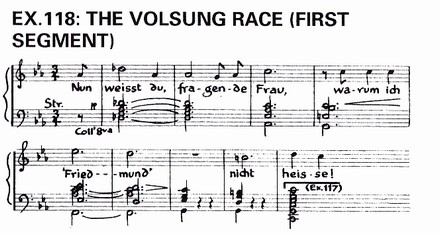
The final segment of Erda's motive generates another heroic motive associated with the Volsungs. This is the dark one introduced in Act 2 of Walkure, when Brunnhilde warns Siegmund of his impending death. It's later attached to Siegfried as doomed hero in Gotterdammerung. Here's the special illustration of Erda's motive again.
《エルダ》のモティーフの最後のセグメントから生成されるモティーフには、ヴェルズング族と結びつく別の英雄的なモティーフがあります。これは『ワルキューレ』の第2幕で導入される暗いモティーフで、ブリュンヒルデがジークフリートに死が差し迫っていることを警告するときに使われます。それは後の『神々の黄昏』において、破滅する英雄としてのジークフリートも表します。《エルダ》のモティーフの特別の例示を再度聴きましょう。
| 《エルダ》: EX.115 |

And here's the motive of the Annunciation of Death, as it recurs on the orchestra near the end of Gotterdammerung when Brunnhilde calls for a funeral lamentation worthy of the dead Siegfried. It too rises slowly out of the final segment of Erda's motive.
そして次が《死の布告》のモティーフで、『神々の黄昏』の最終場面近くでオーケストラに再現するものです。そのときブリュンヒルデは、死んだジークフリートに相応しい葬儀の哀悼を呼びかけます。これもまた《エルダ》のモティーフの最後のセグメントからゆっくりと立ち上がります。
| EX.119は『神々の黄昏』第3幕 第3場。解説にあるように《死の布告》が最初に出るのは『ワルキューレ』第2幕 第4場。 |
| EX.119: 《死の布告》 |

The culminating heroic motive generated by the last segment of Erda's motive is the indomitable one of Siegfried. Here's the special illustration of Erda's motive once more.
《エルダ》のモティーフの最後のセグメントから作られる英雄的なモティーフの頂点にあるのが、不屈のジークフリートを表すものです。《エルダ》のモティーフの特別の例示をもう一度聴きましょう。
| 《エルダ》: EX.115 |

And here's Siegfried motive, like the Valkyries motive, it rises boldly out of the last segment of Erda's motive.
そして次が《ジークフリート》のモティーフで、《ワルキューレ》のモティーフと同じように《エルダ》のモティーフの最後のセグメントから力強く立ち上がります。
| EX.120 は『ジークフリート』第2幕 第2場で、ジークフリートと森の小鳥の "交流" のあと、ホルンの長いソロの中に出てくるもの。このモティーフが最初に出るのは『ワルキューレ』第3幕 第1場でのブリュンヒルデの歌唱。 |
| EX.120: 《ジークフリート》 |

CD2-Track04
One further motive belongs to this heroic family, perhaps surprisingly, this is the motive of Gunther in Gotterdammerung. Gunther does not belong to the offspring of Wotan and Erda in any sense, yet he too is a hero who in his own way tries to establish the claims of love, an attempt which takes a warped form, only because of his weakness which makes him a pawn in the evil plot of his half brother, Hagen. His motive belongs unmistakably, if less than magnificently, to the same heroic family as those associated with the Valkyries and the Volsungs.
このような英雄的なモティーフのファミリーに属するもう一つのモティーフは、たぶん驚かれるでしょうが『神々の黄昏』における《グンター》のモティーフです。グンターは、いかなる意味においてもヴォータンとエルダの子孫ではありません。しかし彼もまた一人の英雄であり、彼なりの方法で愛への要求を確立しようと努めています。しかしこの試みは彼の弱さのためにゆがんだ形にしかなりません。この弱さのために、異父兄弟であるハーゲンの邪悪な計画にかかって手先になってしまうのです。彼のモティーフは堂々としたものではありませんが、間違いなくワルキューレやヴェルズング族に関係した英雄的なモティーフのファミリーに属しています。
| EX.121 は『神々の黄昏』第1幕 第1場の冒頭、グンターの歌唱のところ。 |
| EX.121: 《グンター》 |
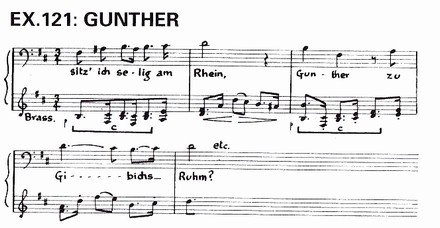
So much for the heroic characters of the drama.
The two central male ones are Siegmund and Siegfried, and the dynamic symbol of their heroism is the Sword created by Wotan which each of them makes his own. And just as the motive is associated with the heroes themselves stem from the motive of Erda which is a form of the Nature motive, so the motive representing the Sword springs from the Nature motive itself. Indeed, we heard earlier that it's a member of the Nature family, being almost identical with the original arpeggio form of the Nature motive.
ドラマの英雄的な登場人物についてはここまでです。
男性の中心的な登場人物はジークムントとジークフリートの2人であり、そのヒロイズムの動的なシンボルは、ヴォータンが作り2人が自分のものとした "剣" です。そして、彼ら英雄自身に結びついたモティーフが《自然》の変形である《エルダ》のモティーフから生成されたように、《剣》を表すモティーフの起源も《自然》のモティーフそのものにあります。実際、すでに聴いたように《剣》は《自然》のファミリーの一員であり、《自然》の原形であるアルペジオの形とほとんど同じでした。
男性の中心的な登場人物はジークムントとジークフリートの2人であり、そのヒロイズムの動的なシンボルは、ヴォータンが作り2人が自分のものとした "剣" です。そして、彼ら英雄自身に結びついたモティーフが《自然》の変形である《エルダ》のモティーフから生成されたように、《剣》を表すモティーフの起源も《自然》のモティーフそのものにあります。実際、すでに聴いたように《剣》は《自然》のファミリーの一員であり、《自然》の原形であるアルペジオの形とほとんど同じでした。
| EX.20 《自然の原形》、および EX.21 《剣》参照。 |
CD2-Track05
The Sword motive recurs many times in the drama, but now we must consider it as another of the basic motives which generates a whole family of motives associated with heroism in action. It first enters on the trumpet in Scene 4 of Rheingold when Wotan conceives the idea of the Sword and of the hero who shall wield it. And we may notice that the musical interval on which it revolves is a downward leaping octave.
《剣》のモティーフはドラマでたびたび現れますが、ここにおいて《剣》は、行動的なヒロイズムに結びつく一連のモティーフのファミリーを作り出す基本モティーフだと考えるべきです。《剣》が最初に現れるのは『ラインの黄金』の第4場でヴォータンが剣のアイデアを思いつき、それを扱うべき英雄を考えるときで、トランペットで演奏されます。それは下向きに跳躍するオクターヴの音程に基づくことに気づくでしょう。
| EX.122: 《剣》 |

This is merely the first segment of the Sword motive. And the much fiercer is the second one, following immediately, and this too is based on the interval of a downward leaping octave. It's sung by Wotan as he explains the purpose of the Sword to secure Valhalla against any attack by enemies, and like the first segment, it recurs later in the drama. Siegmund sings it in Act 1 of Walkure when he remembers that his father Walse, who is of course Wotan, had promised him a Sword in his hour of need.
Here first is the second segment of the Sword motive with its downward leaping octave as sung by Wotan in Scene 4 of Rheingold to indicate the Purpose of the Sword.
これは《剣》のモティーフの第1セグメントだけです。そしてすぐに続く第2セグメントはもっと激しいもので、これも下向きに跳躍するオクターヴの音程に基づきます。それは、剣の目的がヴァルハラを敵の攻撃から守ることだとヴォータンが説明する時の歌唱で使われます。そして第1セグメントと同じくドラマの後の方で再現し、『ワルキューレ』の第1幕のジークムントの歌で使われます。父親のヴェルゼ、つまりヴォータンが、危急の時のための剣を贈ると約束した記憶を語るときです。
まず最初に、下向きに跳躍するオクターヴがある《剣》のモティーフの第2セグメントを聴いてみましょう。これは『ラインの黄金』の第4場でヴォータンが歌うもので、《剣の目的》を示しています。
まず最初に、下向きに跳躍するオクターヴがある《剣》のモティーフの第2セグメントを聴いてみましょう。これは『ラインの黄金』の第4場でヴォータンが歌うもので、《剣の目的》を示しています。
| EX.123: 《剣の目的》 |

And here's the same segment of the Sword motive as sung more quickly by Siegmund in Act 1 of Walkure.
そして次が《剣》のモティーフの同じセグメントで、『ワルキューレ』の第1幕でジークムントがより速いテンポで歌います。
| 以降の EX.124, EX.125, EX.126 は第1幕 第3場。 |
| EX.124: 《剣の目的》 ジークムント |
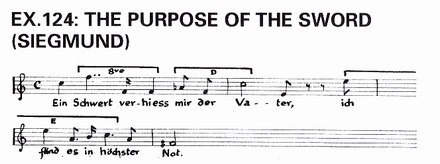
When Siegmund goes on to apostrophize his father, asking him where the Sword is, his voice isolates the downward leaping octave, common to both segments of Sword motive, and it becomes a motive in its own right.
ジークムントが剣の場所を尋ねるため、そこには居ない父に呼びかけをするとき、彼の声は《剣》の2つのセグメントの共通項である下向きに跳躍するオクターヴだけを分離して歌い、それは別のモティーフになります。
| EX.125: 《ヴェルゼ》 |
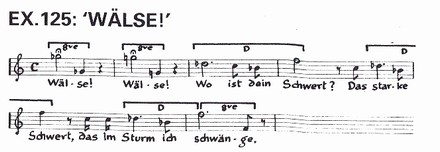
Near the end of Act 1 of Walkure, when Siegmund draws the Sword from the Tree and names it Nothung, or Need, the new motive of the simple downward leaping octave attaches itself to the name.
『ワルキューレ』の第1幕の終わり近くでジークムントが樹から剣を引き抜き、それをノートゥング、つまり "危急の時" と名付けるとき、単純に下向きに跳躍するオクターヴがノートゥングという名前と結びつきます。
| ノートゥングの説明にある "Need" は "必要" ではなく、もっと激しい "難局"、"困窮"、"危機" という意味と解釈できる。「英雄が難局に陥ったときに必要なものがノートゥング」という意味で、ここでは "Need" を "危急の時" とした。EX.123《剣の目的》の "hour of need" の訳も参照。なお、デリック・クックは《The Need of the Gods - 神々の危機》(EX.181)という複合モティーフを取り上げている(後述)。 |
| EX.126: 《ノートゥング》 |

This Nothung motive, associated with the heroes' need for the Sword, recurs in another form in Act 1 of Siegfried. Siegfried sings it when he reforges the Sword and renames it Nothung.
この《ノートゥング》のモティーフは英雄の剣への欲求に関連づけられ、違った形で『ジークフリート』の第1幕で再現します。ジークフリートが剣を鍛え直し、ノートゥングと再命名するときにき歌います(訳注:第1幕 第3場)。
| EX.127: 《ノートゥング》 ジークフリートによる |

This downard leaping octave, stemming from the Sword motive, is used to generate another heroic motive in Act 1 of Gotterdammerung. This is the terse motive of Honor which enters on the orchestra when Siegfried draws the Sword to lay it between himself and Brunnhilde to keep faith with Gunther.
この《剣》から生成された下向きに跳躍するオクターヴは、『神々の黄昏』の第1幕で別の英雄的なモティーフを生み出すのに使われます。それは《名誉》という簡潔なモティーフで、ジークフリートが剣を抜き、彼とブリュンヒルデの間に置いてグンターとの信義を守ろうとするとき、オーケストラに入ってきます。
| EX.128は第3場の最終場面。《名誉》が初めて出てくるのは第2場の EX.52 《贖罪の誓い》のところ。 |
| EX.128: 《名誉》 |

Another important phrase of the Sword motive is the latter half of its second segment referring to the preservation of Valhalla through the Sword. The important interval here is a downward leap of a fifth followed by two steps upward. Let Wotan remind us of this phrase.
《剣》のモティーフの他の重要なフレーズは第2セグメントの後半の部分で、これは剣でヴァルハラを守ることに関係します。ここでの重要な音程は下向きに跳躍する5度と、それに続く2ステップの上昇です。ヴォータンの歌唱でそのところを再確認しましょう。
| デリック・クックの説明がややこしいが、《剣》には2つのセグメントがあり、その第2セグメントが《剣の目的》のモティーフと考えているため上のような説明になる。EX.123《剣の目的》参照。 |
| EX.129: 《剣の目的》 後半 |

This phrase is also taken up by Siegmund in Act 1 of Walkure. He sings it twice over as he grasps the Sword to draw it from the Tree, still remembering his father's promise.
このフレーズもまた『ワルキューレ』の第1幕においてジークムントによって取り上げられます。彼は父との約束を思い出し、剣を握って樹から引き抜こうとするときに2度、このモティーフを歌います。
| EX.130は『ワルキューレ』第1幕 第3場の最終場面。なお、この第3場は EX.124《剣の目的》ジークムント版で始まる。 |
| EX.130: 《剣の目的》後半、ジークムント |

CD2-Track06
Ironically, this phrase, with its downward leap of a fifth followed by two steps upwards, generates a number of motives associated with the various characters and events which stand in the way of Wotan's plans to ensure the safety of Valhalla. In the first place, it forms the basis of the orchestral motive attached to Fricka in Act 2 of Walkure when she argues Wotan into abandoning Siegmund and the Sword and also the purpose for which both were conceived.
皮肉なことに、下向きに跳躍する5度とそれに続く2ステップの上昇というこのフレーズは、ヴァルハラの安全を確保しようとするヴォータンの計画の前に立ちはだかる、さまざまな人物や事件に関連したモティーフのいくつかを生み出します。まず第1に、『ワルキューレ』の第2幕においてフリッカと結びつくオーケストラのモティーフの基礎を形づくります。フリッカがヴォータンを論駁し、ヴォータンがジークムントと剣、およびそれらに与えようとした目的を放棄する時です(訳注:第2幕 第1場)。
| EX.131: 『ワルキューレ』の 《フリッカ》 |

In Act 1 of Gotterdammerung, the same phrase with its downward leap of a fifth, generates further new motive associated with the Gibichungs, who stand in the way of the new possessor of the Sword, Siegfried. The first is the motive of Friendship, the illusory friendship between Siegfried and Gunther.
さらに『神々の黄昏』の第1幕において下向きの5度の跳躍をもつ同じフレーズが、剣の新しい持ち主であるジークフリートに立ちはだかるギビフング族に関連した新しいモティーフを作り出します。その最初は《友情》で、これはジークフリートとグンターの幻の友情を表します(訳注:第1幕 第2場)。
| EX.132: 《友情》 |

Behind the illusory friendship between Siegfried and Gunther stands Hagen and his own personal motive isolates the downward leap of a fifth in its sinister diminished form. It usually enters in the bass as here in Hagen's 'Watch Song'.
この幻の友情の背後には《ハーゲン》がいますが、彼個人を表すモティーフは下向きの5度の跳躍だけを取り出し、不吉な減5度にしたものです。それは普通、次のハーゲンの "見張りの歌" のように低音部に入ってきます。
| EX.133 は『神々の黄昏』第1幕 第2場の最終場面。EX.47 の《指環の力》も同じシーン。 |
| EX.133: 《ハーゲン》 |

Hagen's plan is to use the friendship between Siegfried and Gunther to seduce Siegfried away from Brunnhilde into a marriage with Gutrune. And the motive associated with this Seduction is a freer transformation of the original phrase with the downward leap, altered from a fifth to a seventh, but with the two steps upwards restored. Hagen introduces it vocally when he refers to the "Magic Potion" which is to be the agent of seduction.
ハーゲンの計画は、ジークフリートとグンターの友情を利用し、ジークフリートを誘惑してブリュンヒルデから遠ざけ、グートルーネとの結婚に持ち込むことです。そして次の《誘惑》のモティーフは、元々の下向きの跳躍の自由な変形です。音程は5度から7度に変えられていますが、2ステップの上昇は残っています。これはハーゲンが誘惑の仕掛けとなる "魔法の酒" について語るときの歌に登場します(訳注:『神々の黄昏』第1幕 第1場)。
| EX.134: 《誘惑》 |

The half unwitting instrument of the seduction, Gutrune, has her own personal motive. And this practically returns to the original form of the phrase, for this downward leap of a fifth followed by two steps upward, but now with much sweeter harmonies.
誘惑について半ば無自覚のグートルーネは、彼女自身のモティーフをもっています。これは事実上、下向きの5度の跳躍と2ステップの上昇という元々の形に戻っていますが、和声はもっと甘美です。
| EX.135 は再び『神々の黄昏』第1幕 第2場。ジークフリートに紹介されたグートルーネが広間から去っていくところ。 |
| EX.135: 《グートルーネ》 |

CD2-Track07
Closely associated with Gutrune's motive is the Horn-Call of the Gibichungs which punctuates Hagen's rallying calls to vassals in Act 2 of Gotterdammerung.
《グートルーネ》のモティーフと密接な関係にあるのが《ギビフング族の角笛》のモティーフです。『神々の黄昏』の第2幕においてハーゲンが家臣に集会で呼びかけるとき、その呼応として使われます(訳注:第2幕 第3場)。
| EX.136: 《ギビフングの角笛》 |

A further motive belonging to this family is that of Siegfried's Horn. This is a direct antithesis of the Gibichung's Horn-Call which we've just heard. It begins with an upward leap of a fifth instead of a downward one.
さらに、このモティーフのファミリーに属するのが《ジークフリートの角笛》です。これは、今聴いた《ギビフングの角笛》の直接的な対照物です。下向きの跳躍の代わりに上向きの5度の跳躍で始まります。
| EX.137 は『ジークフリート』第2幕 第2場の EX.120 の直前で、ホルンの長いソロの出だしの部分。なお《ジークフリートの角笛》の初出は『ジークフリート』第1幕 第1場。 |
| EX.137: 《ジークフリートの角笛》 |

In the Prelude to Gotterdammerung, this original fast version of the Horn motive takes on the more majestic form, representing Siegfried's new stature as the active hero inspired by the love of Brunnhilde.
『神々の黄昏』の序幕では、このテンポの速い《角笛》のモティーフの原形がもっと壮大な形になり、ジークフリートの新しい姿を表現します。ブリュンヒルデの愛によって鼓舞された行動的な英雄としての姿です。
| EX.138: 《ジークフリートの角笛》 第2形 |

During the great scene in Act 2 of Gotterdammerung, in which Siegfried and Brunnhilde both swear on Hagen's spear, there's a tremendous conflict between the upward and downward leaping fifths. The result is the motive known as the Swearing of the Oath.
ジークフリートとブリュンヒルデがハーゲンの槍のもとで誓う『神々の黄昏』第2幕の荘厳なシーンでは、上昇と下降の5度が激しくぶつかります。その結果、《誓約の宣誓》として知られるモティーフになります。
| "The Swearing of the Oath" となっているモティーフは《槍の誓約》とも呼ばれる。『神々の黄昏』第2幕 第4場でのジークフリートの歌唱のところに出てくる。 |
| EX.139: 《誓約の宣誓》 |
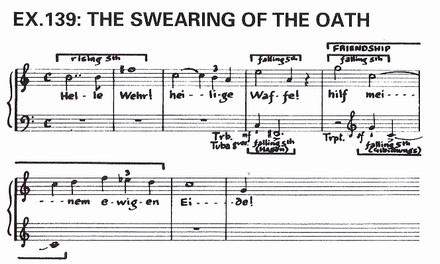
One other motive belonging to this family should be mentioned is that of the World's Inheritance, which enters in Act 3 of Siegfried. This motive, in which the salient interval is a downward leaping sixth followed by several steps of upwards, bursts in on the orchestra to round off Wotan's statement to Erda that he intends to Siegfried and Brunhilde inherit the world.
このファミリーに属するもう一つのモティーフに触れておくべきでしょう。それは『ジークフリート』の第3幕で出てくる《世界の遺産》のモティーフです。このモティーフの顕著な特徴は、下降する6度の跳躍とそれに続く数ステップの上昇です。ジークフリートとブリュンヒルデに世界を継がせるという意図をヴォータンがエルダに語るとき、オーケストラに急に入ってきます(訳注:第3幕 第1場)。
| EX.140: 《世界の遺産》 |

CD2-Track08
Here we come to the end of the family of heroic motives generated by the motive of the Sword with its downward leaping octave and fifth.
But the symbol of heroism, like the symbol of love, has other independent motives attached to it. One of the most important of these is that of Siegfried's Mission which consists of a descending phrase of four notes, repeated in falling sequence. It follows him on the orchestra as he dashes away into the forest in Act 1 of Siegfried, on discovering, to his delight, that he can be free of Mime who has no claim on him at all.
これで英雄的なモティーフのファミリーは終わります。これらは《剣》のモティーフから生成したもので、下向きのオクターヴや5度の跳躍をもっていました。
しかし愛のシンボルと同じように、ヒロイズムのシンボルもそれに結びつく独立したモティーフを持っています。その中で最も重要なのが《ジークフリートの使命》で、下降する4つの音から成り、それが順に下降する形で繰り返されます。それは『ジークフリート』の第1幕でジークフリートが森に突き進むときのオーケストラに出てきます。ジークフリートは、彼に対して何の権利もないミーメから解放される喜びを見出します(訳注:第1幕 第1場 終了近く)。
しかし愛のシンボルと同じように、ヒロイズムのシンボルもそれに結びつく独立したモティーフを持っています。その中で最も重要なのが《ジークフリートの使命》で、下降する4つの音から成り、それが順に下降する形で繰り返されます。それは『ジークフリート』の第1幕でジークフリートが森に突き進むときのオーケストラに出てきます。ジークフリートは、彼に対して何の権利もないミーメから解放される喜びを見出します(訳注:第1幕 第1場 終了近く)。
| EX.141: 《ジークフリートの使命》 第1形 |

This motive of Siegfried's Mission achieves its definitive broad form in the Prelude to Gotterdammerung. He himself sings it in his duet with Brunnhilde when he declares that he is no longer Siegfried but Brunnhilde's arm.
この《ジークフリートの使命》のモティーフは『神々の黄昏』の序幕で堂々とした確定形に到達します。ジークフリート自身がブリュンヒルデとの2重唱でそれを歌います。もはやジークフリートではなく、ブリュンヒルデの腕だと宣言する時です。
| EX.142: 《ジークフリートの使命》 確定形 |

Another form of this motive, with the falling phrases in rising sequence is introduced by Wotan in Act 2 of Siegfried. He sings it when he assures Alberich that Siegfried is an entirely free agent who must stand or fall by his own powers.
徐々に上昇していく下降フレーズを持った別の形のモティーフを『ジークフリート』の第2幕でヴォータンが導入します(訳注:第2幕 第1場)。ジークフリートは完全に自由の身であり、立つにしろ倒れるにしろ自らの力によるべきことを、ヴォータンがアルベリヒに確約するときに歌われます。
| EX.143: 《ジークフリートの使命》 ヴォータン形 |
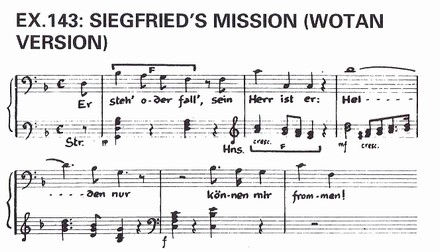
In this form, the motive of Siegfried's Mission forms the basis of the Blood Brotherhood duet in Act 1 of Gotterdammerung. It enters when they sing of their freedom in swearing the oath, and the effect is one of the dramatic irony, since they're both acting as mere pawns in Hagen's plot.
この形の《ジークフリートの使命》のモティーフは『神々の黄昏』の第1幕における《兄弟の血の誓い》の2重唱の基礎となります。これは2人が誓約の自由を歌うときに出てきますが、その効果はドラマとしてのアイロニーです。なぜなら、2人ともハーゲンの陰謀のもとで単なる駒として動いているからです。
| EX.144 とその次の EX.145 は、第1幕 第2場の「兄弟の血の誓い」の場面。EX.145 《兄弟の血の誓い》、EX.144 《ジークフリートの使命》、EX.52 《贖罪の誓い》、EX.128 《名誉》 がこの順で登場する。 |
| EX.144: 《ジークフリートの使命》 アイロニー |

The relationship of this passage to the motive of Siegfried's Mission makes clear that the descending main theme of the Blood Brotherhood duet itself is generated by that motive.
このパッセージと《ジークフリートの使命》の関係から明らかなのは、《兄弟の血の誓い》の下降する主旋律が《ジークフリートの使命》から生成していることです。
| EX.145: 《兄弟の血の誓い》 |
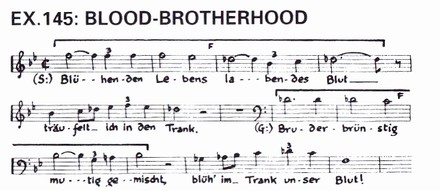
This main theme of the Blood Brotherhood duet itself occurs with great dramatic irony in Act 2 of Gotterdammerung. It enters powerfully on the horns when Gunther, finding himself inextricably involved in Hagen's plot to kill Siegfried, remembers the oath of Blood Brotherhood he swore with him.
《兄弟の血の誓い》の2重唱の主旋律は、『神々の黄昏』の第2幕でドラマとしての大きなアイロニーとして出現します。グンターはジークフリートを殺害しようとするハーゲンの計画に逃れようなく巻き込まれていることを悟りますが、そのときジークフリートと交わした "兄弟の血の誓い" を思い出します。その場面でこのモティーフがホルンに強く現れます。
| EX.146 は『神々の黄昏』第2幕 第5場。EX.75 《ヴォータンの挫折感(ハーゲン形)》と同じ場面。 |
| EX.146: 《兄弟の血の誓い》 アイロニー |
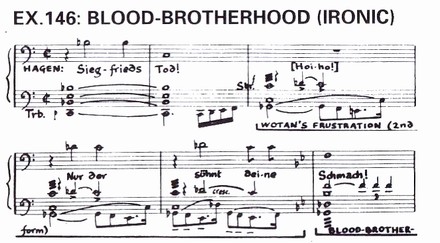
This completes the large number of motives associated with the symbol of heroism in connection with Wotan, Siegmund and Siegfried.
これでヒロイズムというシンボルに関係した、ヴォータン、ジークムント、ジークフリートと結びつく多数のモティーフを終わります。
CD2-Track09
Complementary to this symbol is that of the inspiration given to heroes by women which is represented by the main female characters of the drama, Fricka, Sieglinde and Brunnhilde, each of whom has a motive of this kind. As with the symbol of love, the symbol of woman's inspiring power begins on the subdued level in the power ridden world of Rheingold. The basic motive is the one introduced by Fricka in Scene 2. She sings it when she holds out to Wotan the lure of a comfortable life of Domestic Bliss in Valhalla as a satisfying ideal in itself without any need of further striving. The basis of the motive is two falling intervals, a seventh and a fifth.
以上のシンボルを補足するものとして、女性が "英雄を鼓舞する力" を表すシンボルがあります。つまりドラマの主要な女性キャラクターであるフリッカ、ジークリンデ、そしてブリュンヒルデで表現されるもので、それぞれこの種のモティーフをもっています。愛のシンボルと同じように、"女性の鼓舞する力" のシンボルは『ラインの黄金』という力が支配する世界において控えめに入ってきます。その基本モティーフは、第2場でフリッカが導入します。彼女がヴァルハラ城での家庭的な喜びに満ちた快適な生活の魅力をヴォータンに力説するとき、それを歌います。その生活は、それ以上の努力がいらないという理想を満たすものです。モティーフの基本は5度と7度で下降する2つの音程です。
| EX.147:《家庭の喜び》 |

Little more is heard of this motive. But in Act 3 of Walkure, where the struggle between love and power reaches its height, it's suddenly transformed and lifted onto the heroic plane. Sieglinde, when she learns that she is to bear Siegfried, the hero of the future, sings the ecstatic motive of Redemption. This is also characterized by two falling intervals, both being falling sevenths.
このモティーフはしばらくは出てきません。しかし『ワルキューレ』の第3幕において愛と力の葛藤が最高潮に達するとき、このモティーフは突如変形して英雄的なレベルに引き上げられます(訳注:第1場)。ジークリンデが将来の英雄であるジークフリートを身ごもっていることを知るとき、彼女は《救済》という陶酔的なモティーフを歌います。このモティーフの特徴も2つの下降音程で、ここでは2つとも7度です。
| EX.148:《救済》 |
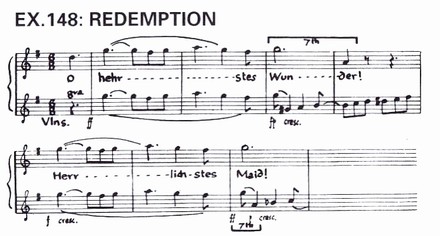
The third motive associated with the inspiring power of woman is Brunnhilde's personal motive in Gotterdammerung, when she has been transformed from a Valkyrie into a Mortal Woman and Siegfried's wife. Again, we notice the falling seventh.
女性の鼓舞する力の3番目は『神々の黄昏』においてブリュンヒルデ個人を表すもので、彼女がワルキューレから《人間の女》に変身しジークフリートの妻になったときのモティーフです。再び、下降する7度に気づきます。
| EX.149 は、EX138《ジークフリートの角笛》第2形と同じく『神々の黄昏』の序幕の途中のオーケストラ間奏曲に出てくる。普通、単に《ブリュンヒルデ》のモティーフと言うと EX.149 を指すが、このモティーフは『神々の黄昏』にしか現れないので、デリック・クック流の "こだわった" 命名がある。 |
| EX.149:《人間の女としてのブリュンヒルデ》 |

This ends the family of motives associated with the inspiring power of woman. Although few, they are extremely powerful.
これで、女性の鼓舞する力に関連したモティーフのファミリーは終わりです。数は少ないものの、大変に強力なモティーフです。
CD2-Track10
One last central symbol remains to be considered, the sense of the mysterious and inscrutable that surrounds human life. The central character here is Loge, the central symbol is Magic Fire. And his flickering chromatic motive is the basic one which generates the rest of this family. It enters on orchestra in Scene 2 of Rheingold when he himself makes his long awaited entry, much to Wotan's relief.
中心的なシンボルで最後に考慮が必要なのは、人間の生活をとりまく神秘的で不可思議な感覚です。ここでの中心的なキャラクターはローゲで、中心的シンボルは "魔の炎" です。そして、ローゲの点滅するような半音階のモティーフが基本モティーフとなって、このファミリーの他のモティーフを作り出します。《ローゲ》のモティーフは『ラインの黄金』の第2場でオーケストラに出てきます。待ちに待ったローゲが登場し、ヴォータンが安堵する場面です。
| EX.150: 《ローゲ》 |

Loge's motive consists of several segments. The most important one is that associated with the Magic Fire which we can hear clearly from a special illustration, the segment played by the orchestra alone.
《ローゲ》のモティーフは数個のセグメントから成っています。最も重要なのは《魔の炎》に関連したセグメントで、それは特別の例示ではっきりと聴けます。このセグメントをオーケストラだけで演奏してみましょう。
| EX.151: 《魔の炎》 |
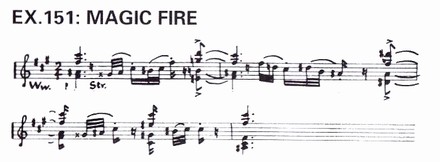
This is the segment of Loge's motive which dominates the Final Scene of Walkure where Wotan calls on Loge to surround the sleeping Brunnhilde with a wall of Magic Fire.
《ローゲ》のモティーフのこのセグメントが『ワルキューレ』の最終場面を支配します。そこではヴォータンがローゲを呼びつけ、眠るブリュンヒルデを魔の炎で囲むように命じます。
| EX.152: 《魔の炎》 ワルキューレ最終場面 |

In the meantime, this segment of Loge's motive has already generated a new motive of Magic that of the Tarnhelm introduced by muted horns in Scene 3 of Rheingold. This is based on the harmonic progression of the Magic Fire segment of Loge's motive, slowed down, in the minor, and without its flickering figuration.
その前に既に、この《ローゲ》のモティーフのセグメントは魔法に関係した新たなモティーフを生み出しています。それは『ラインの黄金』の第3場で弱音器付きのホルンで導入される《隠れ兜》のモティーフです。これは《ローゲ》の《魔の炎》のセグメントの和声進行が基礎になっていて、それをゆっくりとした短調にして点滅するような音符の形を取り除いたものです。
| EX.153: 《隠れ兜》 |

The Tarnhelm motive itself becomes the starting point of another new motive of Magic in Gotterdammerung. In Act 1, when Hagen explains the powers of the Magic Potion to Gutrune, we hear the Tarnhelm motive in the background with two statements of the sensuous segment of Freia's motive in the foreground. And after the second statement of Freia's motive, the Tarnhelm motive straight away transforms itself into the elusive new motive of the Potion.
その《隠れ兜》のモティーフ自体が『神々の黄昏』において魔法に関係した別の新しいモティーフの起点となります。第1幕でハーゲンがグートルーネに "魔法の酒" の威力を説明するとき、《フライア》のモティーフの官能的なセグメントが2度提示されますが、その背後に《隠れ兜》のモティーフを聴くことができます。そして《フライア》のモティーフの2度目の提示のあとで《隠れ兜》のモティーフはすぐに、つかみどころのない新しいモティーフ、《魔法の酒》に変形します。
| EX.154は『神々の黄昏』第1幕 第1場。EX.134 《誘惑》の直後。 |
| EX.154: 《魔法の酒》 |
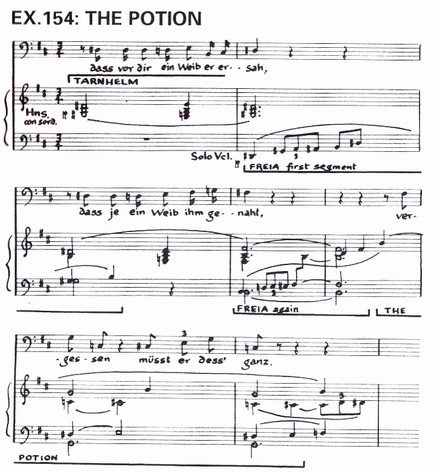
The other important segment of Loge's motive is a series of first inversion chords running up and down the chromatic scale. The version that generates other motive is the descending one.
《ローゲ》のモティーフの重要なセグメントのもう一つは、半音階を上昇して下降する一連の "第1転回和音" です。他のモティーフを生み出すのはその下降する部分です。
| EX.155: 《ローゲ》 半音階セグメント |

This segment also slows down and loses its flickering figurations to produce the motive of the Magic Sleep which descends on Brunnhilde in the Final Scene of Walkure.
このセグメントもまたテンポを落とし点滅するような形を失って、《魔の眠り》のモティーフを生み出します。それは『ワルキューレ』の最終場面でブリュンヒルデに降臨します。
| EX.156: 《魔の眠り》 |
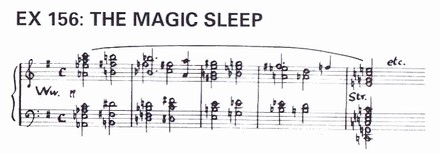
This same segment of Loge's motive is more freely transformed to generate the mysterious motive associated with Wotan in his role as the Wanderer in Siegfried. It first appears on the orchestra when he enters Mime's hut in Act 1.
《ローゲ》のモティーフのこの同じセグメントはもっと自由な変形を加えられ、『ジークフリート』でヴォータンが演じる《さすらい人》に結びつく神秘的なモティーフを生み出します。それは、第1幕においてヴォータンがミーメの小屋を訪れるとき、オーケストラに初めて現れます(訳注:第1場)。
| EX.157: 《さすらい人》 |
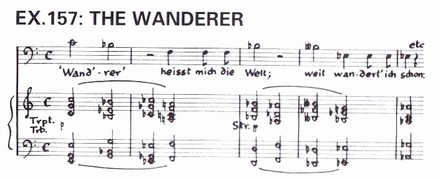
CD2-Track11
One further motive connected with Magic and Mystery is not directly derived from Loge's motive, but is related to its general chromatic character. It's one of the shortest, yet one of the most important in The Ring, a chromatic progression of two chords only, which is associated with the inscrutable workings of Fate. It first enters on tubas when Brunnhilde comes to Siegmund in Act 2 of Walkure to warn him that he is to die.
魔法と神秘に結びつくもう一つのモティーフは《ローゲ》のモティーフから直接的に導かれるものではありません。しかし、全体的な半音階の特徴が《ローゲ》に関係しています。それは『指環』の中では最も短いモティーフの一つですが、最も重要なものの一つで、《運命》の不気味な働きに関連した2つの和音だけの半音階的進行です。それは『ワルキューレ』の第2幕において、ブリュンヒルデがジークムントのところに来て死が迫っていることを警告するときに、チューバに初めて現れます。
| EX.158は『ワルキューレ』第2幕 第4場。同じ場で EX.119《死の布告》も初めて現れる。 |
| EX.158: 《運命》 |

This motive of of two chords suggests the workings of Fate by moving mysteriously from one key to another with each repetition. But the very end of Walkure, Fate is suspended, as it were, while Brunnhilde sleeps, and so the Fate motive, in spite of the repetitons, is held fixed in the key in which the Opera ends.
この2つの和音のモティーフは繰り返しごとに2つの調性の間を神秘的に動き、それによって運命の働きを暗示します。しかし『ワルキューレ』の最終場面においてブリュンヒルデが眠りにつくと《運命》はいわば中断され、繰り返しは残っているものの、調性が楽劇の終わりまで固定されたままになります。
| EX.159: 《運命》 ワルキューレ最終場面 |

When Brunnhilde is awoken in Act 3 of Siegfried, almost her first words are "Long was my sleep", and she sings this suspended version of the Fate motive which we've just heard. Then, she sings "I am awake", the Fate motive returns to its original form, moving into a new key, to suggest that, from this point onwards, Fate is at work again.
『ジークフリート』の第3幕においてブリュンヒルデが目覚めたとき、最初の言葉は「眠りは長かった」です。そして彼女は、私たちが今聴いたばかりの《運命》のモティーフの固定された形を歌います。そして次に彼女が「目覚めました」と歌うとき、《運命》のモティーフは新しい調性に移って元々の形に戻ります。これ以降、再び運命が働き出すことを暗示しているのです。
| EX.160: 《運命》 ブリュンヒルデ |

This passage makes clear that the bright motive of two chords to which Brunnhilde actually awakes is itself generated by the Fate motive suggesting the working of Fate towards a more happy end, at least for the time being.
このパッセージで明らかなことは、ブリュンヒルデが実際に目覚めたときの明るい2つの和音のモティーフ自体が《運命》のモティーフから生成されていることです。そして少なくともしばらくの間は、運命の働きがより幸せな結果に向かうことを暗示しています。
| EX.161: 《ブリュンヒルデの目覚め》 |

This brings to an end the family of motives associated with the symbol of Magic and Mystery.
これで、魔法と神秘に関係したモティーフのファミリーは終わりです。
ライトモティーフ譜例一覧(4)
|
| 英雄 |
| 《 | エルダ》 | |||
| 《 | ワルキューレ》 | |||
| 《 | ヴェルズング族》主セグメント | |||
| 《 | ヴェルズング族》第1セグメント | |||
| 《 | 死の布告》 | |||
| 《 | ジークフリート》 | |||
| 《 | グンター》 |
| 英雄 ─ 剣 |
| 《 | 剣》 | |||
| 《 | 剣の目的》 | |||
| 《 | 剣の目的》ジークムント | |||
| 《 | ヴェルゼ》 | |||
| 《 | ノートゥング》 | |||
| 《 | ノートゥング》ジークフリートによる | |||
| 《 | 名誉》 | |||
| 《 | 剣の目的》後半 | |||
| 《 | 剣の目的》後半、ジークムント | |||
| 『 | ワルキューレ』の《フリッカ》 | |||
| 《 | 友情》 | |||
| 《 | ハーゲン》 | |||
| 《 | 誘惑》 | |||
| 《 | グートルーネ》 | |||
| 《 | ギビフングの角笛》 | |||
| 《 | ジークフリートの角笛》 | |||
| 《 | ジークフリートの角笛》第2形 | |||
| 《 | 誓約の宣誓》 | |||
| 《 | 世界の遺産》 | |||
| 《 | ジークフリートの使命》第1形 | |||
| 《 | ジークフリートの使命》確定形 | |||
| 《 | ジークフリートの使命》ヴォータン形 | |||
| 《 | ジークフリートの使命》アイロニー | |||
| 《 | 兄弟の血の誓い》 | |||
| 《 | 兄弟の血の誓い》アイロニー |
| 英雄 ─ 女性が英雄を鼓舞する |
| 《 | 家庭の喜び》 | |||
| 《 | 救済》 | |||
| 《 | 人間の女としてのブリュンヒルデ》 |
| 魔法と神秘 |
| 《 | ローゲ》 | |||
| 《 | 魔の炎》 | |||
| 《 | 魔の炎》ワルキューレ最終場面 | |||
| 《 | 隠れ兜》 | |||
| 《 | 魔法の酒》 | |||
| 《 | ローゲ》半音階セグメント | |||
| 《 | 魔の眠り》 | |||
| 《 | さすらい人》 | |||
| 《 | 運命》 | |||
| 《 | 運命》ワルキューレ最終場面 | |||
| 《 | 運命》ブリュンヒルデ | |||
| 《 | ブリュンヒルデの目覚め》 |
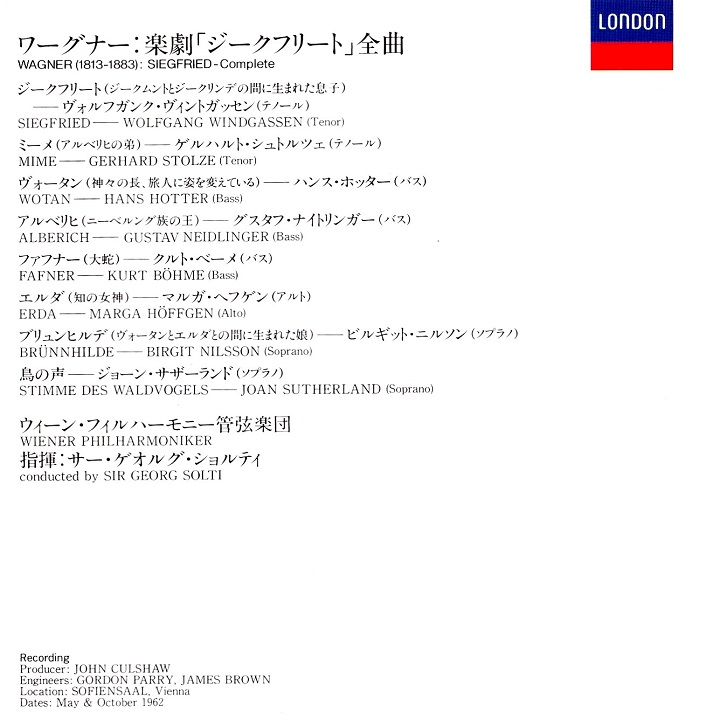
|
2019-06-07 18:19
nice!(1)



